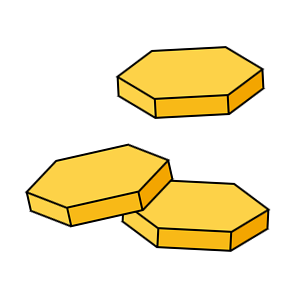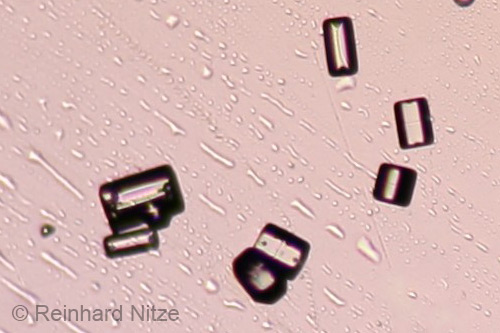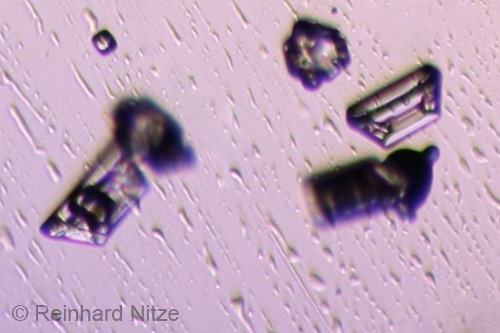Ice Crystals in the Atmosphere
When humid warm air meets cold air, the warm air rises and slides over the cold air. During this process, the humid air cools down. Cold air cannot absorb as much water vapor as warm air, so the excess water condenses into clouds. This way, water reaches a height of 8-10 km. Up there, the temperature is only about -15 to -20°C, so a large part of the water droplets freeze into ice crystals. However, the water does not automatically crystallize. Instead, sublimation nuclei (tiny dust particles) are required to cause the water vapor to condense and the water to freeze suddenly. The crystals responsible for halo phenomena form only at temperatures below -10°C. You can observe the condensation of water and the subsequent freezing very well on the contrails of airplanes. What you see are not the airplane's exhaust gases themselves, but ice crystals or water droplets that form suddenly on the soot particles of the exhaust. The contrails are also a very good indicator of humidity at high altitudes. If the contrails are short and dissolve quickly, the air is quite dry. But if broad and persistent contrails are visible, the air is saturated with water vapor. Even if no clouds are visible except for the contrails, it is very likely that high clouds, mainly composed of ice crystals, will form in the next few hours.
Ice crystals are hexagonal. They usually have 6 prism faces and 2 base faces. Such crystals can refract light like in a 60° prism. Then the light enters through a prism face and exits through the next but one. The light cannot leave the adjacent prism face due to total reflection. In addition, refraction with an angle of 90° occurs. Here, the light enters through a base face and exits through a prism face. These two light paths alone can cause a variety of halo types.
The various types of halos result from the fact that the crystals can assume different orientations in space. Each type of orientation produces its own halos, even though the path of light within the crystal remains the same. In the following halos, the path of light is identical:
- 22° ring (random)
- Sun dogs (horizontal base)
- Contact arcs or circumscribed halo (vertical base)
- Parry arc (vertical base and two horizontal prism faces)
Types of Crystals and Their Orientation
Randomly Oriented Columnar Crystals

When ice crystals fall undisturbed, they automatically assume a certain orientation. Plates align with the base horizontally, column crystals with the main axis horizontally. However, it often happens that turbulence in the atmosphere prevents orientation. Then the plates and columns take on all possible positions in space. In addition, there are ice crystals that are about as long as they are wide. Such equally dimensioned crystals usually have no preferred orientation even in calm atmospheres. The randomly oriented crystals only produce two types of halos: the 22°-ring and the 46°-ring.
Horizontally Oriented Plate Crystals

When plate-shaped ice crystals fall undisturbed, they orient themselves with the base horizontal. In the graphic, the base surfaces are the upper and lower sides of the crystal. The six side surfaces are called prism faces. The light rays can pass through the crystal in various ways. If they enter a prism face and exit at the next prism face, the refraction angle is 60°. If they enter a base face and exit at a prism face, the refraction angle is 90°. Additionally, the light can be reflected inside the crystal before it exits. The different light paths create different halo phenomena. The most common halo phenomena caused by horizontal plates are the parhelia and the circumzenithal arc.
Simply Oriented Column Crystals

When columnar crystals fall undisturbed, they align with the main axis horizontally. The main axis goes through the center of the two base surfaces. Around this axis, the crystals can take any position. Such crystals are referred to as simply oriented columnar crystals. Here too, angles of refraction of 60° and 90° are possible. Columnar crystals produce a great variety of halo phenomena. The most common are the contact arcs and the circumscribed halo.
Double-Oriented Column Crystals
Randomly Oriented Pyramidal Crystals

Column and plate crystals have 6 prism faces and 2 base faces, so a total of 8 sides. Pyramidal crystals, on the other hand, have 6 regular prism faces, 12 pyramidal faces, and 2 base faces, so a total of 20 sides. Because of the large number of crystal faces, many different halo phenomena are possible. If the crystals are randomly distributed, the 22° ring is produced by refraction at the regular prism faces. In addition, there are several other paths of rays that then cause rings with unusual radii.
Vertically oriented pyramidal crystals

Pyramidal crystals can also be oriented horizontally or vertically. Then contact arcs with unusual radii form to the halos.
Rotating Plate Crystals

The prevalent theory assumes that rotating or oscillating plate crystals can exist in such large numbers that they generate their own halos. The axis of rotation runs between two opposite points on the base surface (see illustration). Rotating plates could explain the Lowitz arcs, which run from the parhelia to the 22° halo.



